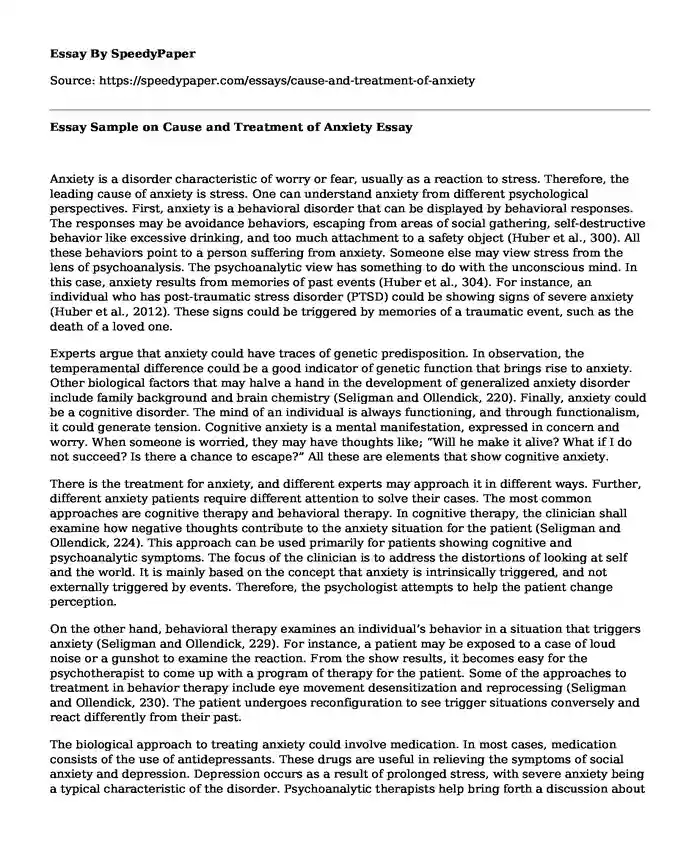
| Essay type: | Problem solution essays |
| Categories: | Medicine Stress Anxiety disorder |
| Pages: | 3 |
| Wordcount: | 643 words |
Anxiety is a disorder characteristic of worry or fear, usually as a reaction to stress. Therefore, the leading cause of anxiety is stress. One can understand anxiety from different psychological perspectives. First, anxiety is a behavioral disorder that can be displayed by behavioral responses. The responses may be avoidance behaviors, escaping from areas of social gathering, self-destructive behavior like excessive drinking, and too much attachment to a safety object (Huber et al., 300). All these behaviors point to a person suffering from anxiety. Someone else may view stress from the lens of psychoanalysis. The psychoanalytic view has something to do with the unconscious mind. In this case, anxiety results from memories of past events (Huber et al., 304). For instance, an individual who has post-traumatic stress disorder (PTSD) could be showing signs of severe anxiety (Huber et al., 2012). These signs could be triggered by memories of a traumatic event, such as the death of a loved one.
Experts argue that anxiety could have traces of genetic predisposition. In observation, the temperamental difference could be a good indicator of genetic function that brings rise to anxiety. Other biological factors that may halve a hand in the development of generalized anxiety disorder include family background and brain chemistry (Seligman and Ollendick, 220). Finally, anxiety could be a cognitive disorder. The mind of an individual is always functioning, and through functionalism, it could generate tension. Cognitive anxiety is a mental manifestation, expressed in concern and worry. When someone is worried, they may have thoughts like; “Will he make it alive? What if I do not succeed? Is there a chance to escape?” All these are elements that show cognitive anxiety.
There is the treatment for anxiety, and different experts may approach it in different ways. Further, different anxiety patients require different attention to solve their cases. The most common approaches are cognitive therapy and behavioral therapy. In cognitive therapy, the clinician shall examine how negative thoughts contribute to the anxiety situation for the patient (Seligman and Ollendick, 224). This approach can be used primarily for patients showing cognitive and psychoanalytic symptoms. The focus of the clinician is to address the distortions of looking at self and the world. It is mainly based on the concept that anxiety is intrinsically triggered, and not externally triggered by events. Therefore, the psychologist attempts to help the patient change perception.
On the other hand, behavioral therapy examines an individual’s behavior in a situation that triggers anxiety (Seligman and Ollendick, 229). For instance, a patient may be exposed to a case of loud noise or a gunshot to examine the reaction. From the show results, it becomes easy for the psychotherapist to come up with a program of therapy for the patient. Some of the approaches to treatment in behavior therapy include eye movement desensitization and reprocessing (Seligman and Ollendick, 230). The patient undergoes reconfiguration to see trigger situations conversely and react differently from their past.
The biological approach to treating anxiety could involve medication. In most cases, medication consists of the use of antidepressants. These drugs are useful in relieving the symptoms of social anxiety and depression. Depression occurs as a result of prolonged stress, with severe anxiety being a typical characteristic of the disorder. Psychoanalytic therapists help bring forth a discussion about the unconscious mental material of a patient (Luyten and Blatt, 103). When this happens, the thought patterns and reactions of a patient can be reshaped and aligned to help one control emotions and feelings better.
Works Cited
Huber, Dorothea, et al. "Comparison of cognitive-behavior therapy with psychoanalytic and psychodynamic therapy for depressed patients–a three-year follow-up study." Zeitschrift für Psychosomatische Medizin und Psychotherapie 58.3 (2012): 299-316.
Luyten, Patrick, and Sidney J. Blatt. "Psychodynamic treatment of depression." Psychiatric Clinics 35.1 (2012): 111-129.
Seligman, Laura D., and Thomas H. Ollendick. "Cognitive-behavioral therapy for anxiety disorders in youth." Child and Adolescent Psychiatric Clinics 20.2 (2011): 217-238.
Cite this page
Essay Sample on Cause and Treatment of Anxiety. (2023, Aug 21). Retrieved from https://speedypaper.net/essays/cause-and-treatment-of-anxiety
Request Removal
If you are the original author of this essay and no longer wish to have it published on the SpeedyPaper website, please click below to request its removal:
- Essay Sample: Medical Sales Cover Letter
- The History of Bipolar Disorder, Essay Sample
- Essay Sample on Reducing Infections in Nursing Homes
- Free Essay: Modern-Day Psychiatrist's Diagnosis for the Main Character in "The Yellow Wallpaper"
- Sampling Method and Study Design - Free Essay
- Nursing Sensitive Quality Indicators - Free Essay Sample
- Health Risks of Obesity - Paper Example
Popular categories




